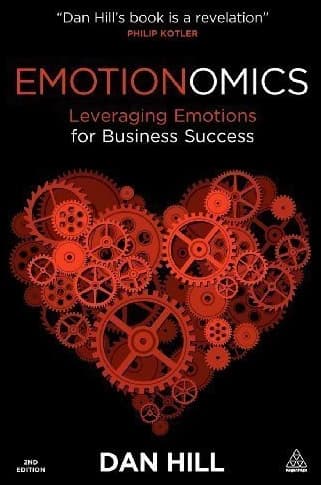Emotionomics: Leveraging Emotions for Business Success
- Written by
- Dan Hill
- Added
- March 04, 2014
Book review

Emotionomics: Leveraging Emotions for Business Success by Dan Hill
Reviewed for SOFII by Charlie Hulme.
There’s no art to find the mind’s construction in the face.
William Shakespeare
It turns out that Shakespeare was wrong. Dan Hill’s book shows there’s more than an art, there’s a science known as facial coding that closes the enormous gap between what people say and what they feel.
There’s a rational/emotional split in all of us. Who among us doesn’t want to appear more logical than we actually are? The effort of maintaining this appearance creates a gap between what we feel and what we say, and between what we say and do.
For a great illustration watch Woody Allen’s ‘ Annie Hall’. As a couple on their first date are speaking subtitles appear saying what they really mean. Your supporters and prospects do exactly the same thing. So how do you tap into their emotional sub text? By not listening to what they say, but studying how they look as they say it.
Before we get into the ‘how’ of facial coding we need to understand the ‘why’.
The emotional part of the brain is much larger than the rational. The rational brain literally grew out of the emotional brain and remains intricately tied to it. The signals that run from the emotional brain to the rational outnumber those running in the opposite direction by a ratio of 10 to one.
Consider the fact that only the sensory and emotional brain centres direct our muscle activity. Decision-making is not a logical process; when faced with danger we don’t intellectually weigh up the pros and cons, we run. Feelings happen before thought and they happen at great speed. When making a decision we go with our gut and then use intellect for justification after the fact.
Of course fundraisers talk about ‘emotion’ all the time, but do any of us really know what we mean? Too often the discourse gets confused with terms that aren’t emotions at all but organisational objectives masquerading as feelings. ‘Relevant’ isn’t an emotion, nor is ‘warm’, nor is ‘familiar.’ Yet these words appear time and again in creative briefs.
And even though we think we’re being emotional, there’s a huge reticence when it comes to putting it into practice. No matter how emotional an appeal may be at draft stage, when it comes to sign off we find comfort in throwing in a few statistics just for good measure. Our sector is without doubt the worse culprit of what Dan calls ‘message-itis’: attempting to persuade by loading up with extra, rationally oriented messages that overly complicate execution.
I have sat in countless meetings where I’ve been told ‘our donors are very rational people’, as though the mere fact of supporting that charity outweighed neuroscientific fact.
Perhaps our sector has had a valid point in being wary of emotion. After all it’s natural to be reluctant about dealing in a (up till now) non-measurable medium. Without an accurate measuring tool, how can emotions be strategically anticipated or tactically handled?
Facial coding presents a quantifiable answer. At their most basic, the emotions can be boiled down to seven archetypes: surprise, fear, anger, sadness, disgust, contempt, and happiness. Our face reveals which of those we are feeling before we are consciously aware of it. Emotional facial response is so universal, so innate that even a person born blind displays the same facial expressions as those who can see.
Tremendous possibility for good is on offer
Facial coding offers a viable means of measuring and managing emotional responses. Companies using this method are able to design their offering based not on what people say but on what they truly feel, with staggering results. In one instance almost 60 per cent of participants viewing a test television ad gave a positive verbal response, but their face (their true self) revealed that less than a third had a positive emotional response.
Imagine the tremendous possibility for good this offers our sector. How many times have you based your creative message on the findings of a research group, only to find out they didn’t respond the way they said they would? How many times have you heard the story of surveys showing people don’t like to see images of suffering, yet when they’re replaced with positive ones response and values significantly drop?
Rational messages don’t win people over. Being on message is not enough. Success depends on being on emotion. Nowhere is this more true than in fundraising. We have a real opportunity to change the face of fundraising. Please let’s not wait decades to implement a new system that’s working so well for the commercial world. Let’s grab it with both hands. We owe it to those we serve.
The face is a picture of the mind as the eyes are its interpreter.—Cicero
Published by Kogan Page, UK, 2009, paperback.
About Charlie Hulme
 Charlie Hulme is managing director of Donor Voice. He is an expert on taking the guesswork (and subsequent time, effort and money wasted) out of strategy. He helps charities dramatically improve performance, value and retention.
Charlie Hulme is managing director of Donor Voice. He is an expert on taking the guesswork (and subsequent time, effort and money wasted) out of strategy. He helps charities dramatically improve performance, value and retention.
Voted top speaker at the Institute of Fundraising’s National Convention in 2013, he writes frequently for SOFII, 101 Fundraising, the Institute of Fundraising and many others.

















